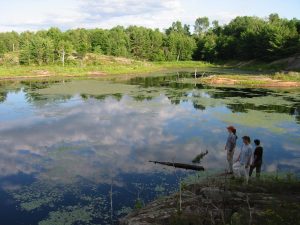Walking hand in hand
First and foremost, The Land Between acknowledges the privilege of living on this land, made possible by the generosity and openness of Indigenous Peoples in the creation of the original treaties. These treaties established that the Anishinaabe and other Indigenous Nations would remain the primary caretakers of the land, water, and wildlife, retaining their full rights, freedoms, and self-determination. While recorded in the Great Wampum and enshrined in the British North America Act and Canada’s Constitution, we recognize that these agreements have not always been honored.
The Land Between operates with at least 50% Anishinaabe representation on its Council, including a delegate appointed by at least one central First Nation community within the bioregion. We honor the enduring and inherent rights of Indigenous Peoples in all that we do. We do not represent or speak for Indigenous Peoples in The Land Between, but we are committed to strengthening partnerships and engagement with Anishinaabe communities as we build capacity together.

The Land Between is the first charity in Canada, to its knowledge, to embrace co-management as a governing structure and use Traditional Talking Circles for decision making. All decisions are made through consensus and without hierarchy by the Council, which is composed of Indigenous Peoples, conservation experts, landowners, and non-experts alike across generations. In this way, the council reflects the community The Land Between serves.

We embrace Traditional Ecological Knowledge (TEK) alongside western science. Rather than seeking to validate TEK with western science, we value TEK in its own right. This practice, known as Two-Eyed Seeing, is central to how we operate at The Land Between. Similarly, the charity values the practical knowledge that is informed by interaction with nature and wildlife gathered through time spent outdoors.

We believe that multiple perspectives, experiences, and from various sectors and disciplines is important. Often local knowledge and experience is left out of the dialogue and decisions. This includes knowledge of nature, community history, and even economies. Therefore, we strive to listen and embrace these perspectives to find balanced and also effective solutions.
Bioregionalism
At its heart, bioregionalism is the understanding that land and people shape each other. The Land Between fosters this connection, cultivating a shared identity that celebrates and conserves the bioregion. Our vision: a future where communities thrive in balance, sustaining both their culture and the landscapes they call home.
Watch our documentary
For more on who The Land Between is and how we operate, check out our documentary! You can watch the series introduction (left) or watch full clips at this link.
To view the entire documentary, purchase if from our online store on Blu-Ray!
More on how we operate




LISTENING
In addition to the Council and COO, The Land Between relies on its Advisory Circle for guidance and peer review. This non-voting group includes experts from universities and NGOs, as well as youth and community members. Their input helps steer projects and ensures the charity’s actions truly reflect the needs of the community.
WISE USE OF FUNDS
The Land Between’s community embodies an entrepreneurial spirit. We work with and hire local talent to support the regional economy while keeping overhead low. The Chief, to date, draws no full-time salary, receiving compensation only for operational roles tied to successful grants and projects. Our lean, dedicated staff ensures efficient, mission-focused operations.
EMBRACING DIFFERENCE
We don’t follow extremes or factions. Instead, we strive for balance and learn from differences. Diversity—of genes, species, peoples, and perspectives—enriches us and makes us stronger. True solutions emerge by embracing differences, honoring diverse knowledge and perspectives, which provide both insight and opportunity.
PRECAUTIONARY PRINCIPLE
Nature is dynamic and alive. By applying the precautionary principle, we treat natural capital like a vital investment—preserving its capacity to renew ensures resilience for people and future generations. Our focus is on protecting renewal, especially within interlinked systems and priority places.

